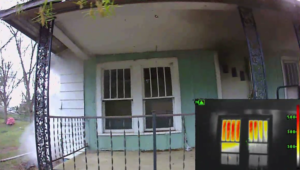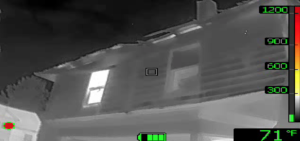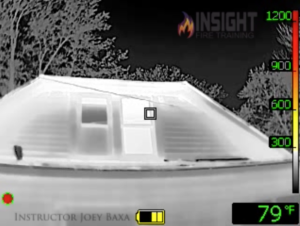In many cases, firefighters fail to recognize abnormal thermal signatures, cues, or thermal bridging that is indicative of high heat signatures within a structure.
But what about windows?
Many have been taught that a TIC cannot see through glass. When in fact, thermal imaging cameras do not “see through” anything. They detect temperature differences on surfaces.
As shown in the following video of a defensive fire, this window has a storm window on the outside. The window produces a uniform temperature pattern which could be mistaken for solar loading or a reflection.
https://youtu.be/STouENarUfw
But, if we look:
* Above the window
* Around the window
* And additional abnormal heat signatures
We can detect that there is a large amount of heat behind this window.
And context is everything!
* Single Pane Glass allows Infrared Energy to transfer through. As shown in the following photos, heat transfer can be viewed through the thermal imaging camera when significant heat is near single pane glass windows.

The photo above features a single pane leaded glass windows from the early 1900’s viewed through a Scott X380 TIC.

The photo above features single pane glass with a storm window covering the window. The fire originated in the front of the home and is extending to the rear. The adjacent room has the door closed where as the window that is highlighted with heat signatures has the door open.
* Double Pane Glass (Low E-Glass) reflects energy but heat transfer heats up the argon/inert gases within the two window panes producing non-uniform/abnormal heat signatures. In the photo below, this home has one double pane low e-glass window on the left and a single pane glass window on the right. A burn barrel is within a few feet of both windows in the interior room. There are heat signatures visible on both windows but vary in their appearance. The double pane window appears different than any other window in the structure with an abnormal non-uniform patter across the top half of the window frame while the remaining portion of this pane is appearing to be cold but only due to reflecting the apparent temperatures of the exterior conditions. Whereas the single pane window on the right is showing a uniform white heat signature but no other window in the home shows this appearance. This allows firefighters to diagnose the possible area of the fire.

* Commercial grade windows may no show heat transfer but signs of heat transfer or thermal bridging may be evident around the edges around the window. Commercial windows vary in glass thickness and insulation properties. In many cases, there may be no obvious signs of heat around these windows due to fire conditions until the window is near its failure point.
As Tom Zind states in his article “The Language of Heat”, we should know more about what we are looking at than what we are viewing the object through.
Building Thermologists understand and use these techniques on a daily basis to find faults, leaks, and issues in buildings with thermal imaging cameras. Firefighters can learn tremendously important skills and concepts from thermography professionals.
Stay Intelligently Aggressive!
Instructor Andy Starnes
Insight Training LLC
Level II Thermography Certified
